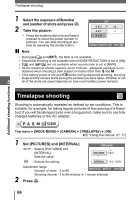Olympus SP 500 SP-500 UZ Advanced Manual (English) - Page 70
Changing the monitor and viewfinder display (DISP./GUIDE
 |
UPC - 050332156173
View all Olympus SP 500 manuals
Add to My Manuals
Save this manual to your list of manuals |
Page 70 highlights
Changing the monitor and viewfinder display (y) 1 Take the picture. • When recording starts, aim the camera microphone at the source of the sound you want to record. Microphone Additional shooting functions TIPS • H is displayed when still pictures with sound are played back. During playback, sound is output from the speaker. The volume can be adjusted. g"Setting camera sounds (8/BEEP/SHUTTER SOUND/VOLUME)" (P. 107) • Sound can be added later to still pictures. Recorded sound can also be re- 5 recorded. g"Adding sound to still pictures" (P. 86) Note • If the microphone is farther than 1 m (3.3 ft.) from the subject, sound may not be recorded properly. • Pictures cannot be taken during sound recording. • Recording sound with still pictures is not available during sequential shooting, panorama shooting, or timelapse. • Sound recording may also pick up camera noises, such as button operations, shutter movement, etc. • Sound recording may not be possible if there is insufficient space in the internal memory or the card. Changing the monitor and viewfinder display (DISP./GUIDE) This function displays histograms and lines that help you to compose your pictures. Also, you can hide the shooting information from being displayed on the monitor. 70















